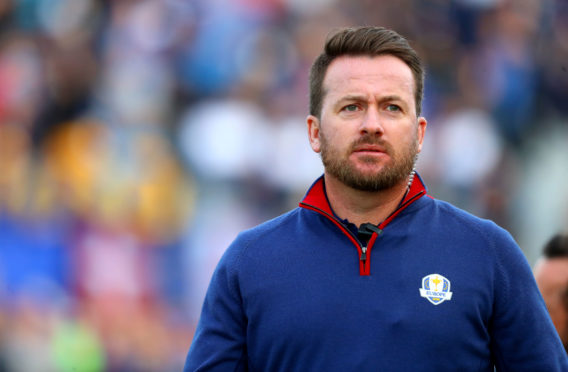Padraig Harrington was joking – I think – when he tweeted forlornly about his latest dilemma for the Ryder Cup in September.
The new captain will – has to in fact – maintain the famous continuity that has built the astonishing success of Team Europe over the last 25 years.
Three weeks into peak season on the European Tour, however, and two of his certain assistants for Whistling Straits are showing real capability to get on the team. Lee Westwood’s win at Abu Dhabi has been quickly followed by Graeme McDowell’s at the weekend in Saudi.
Westwood and McDowell were both in Thomas Bjorn’s backroom staff in Paris, poring over the stat sheets which plotted the way to dominating victory over the USA. McDowell in particular is sociable, widely popular with all and a natural diplomat, while Harrington is not really any of those things.
GMac is still only 40, well below retirement age for Ryder Cup purposes, and still probably has three or four editions before he’ll be considered for the captain’s job himself. Since being a cornerstone of the wins in 2010, 2012 and 2014, however, his play for himself hasn’t merited selection.
One win doesn’t signal a renaissance, but that was a top quality field he beat on the Red Sea coast.
Even after the triumph of Paris, Europe’s personnel is still going through something of a transition. Last time in Paris seven of Europe’s 12 were over 35, and three wildcards – Henrik Stenson, Ian Poulter and Paul Casey – are now well into their 40s.
Some of these guys, through simple natural wear and tear as much as form, are not going to make it to Wisconsin.
Which to my mind makes it fine if McDowell or Westwood make the team, even as potential wildcards if their form isn’t quite good enough to make the qualifying points.
The new base trio is Rory McIlroy, Jon Rahm and Tommy Fleetwood. There will be maybe three or four rookies adding to that, plus the possibility of a Thomas Pieters or Rafa Cabrella Bello or Matt Fitzpatrick making the team after missing out last time.
That group’s still going to need a bit of experienced backbone like McDowell and Westwood can provide. The guys they’ll replace will probably be the elder statesmen from last time, and their experience can still be accommodated within Harrington’s backroom brains-trust.
I’m far more optimistic about Europe’s chances this year than I was before Hazeltine, even before Medinah.
That doesn’t mean they’re going to win, but it does mean that the evolution of the European team is being handled well and the competitiveness of the Ryder Cup, central to its appeal since the mid-1980s as golf’s most popular (and lucrative) event, is pretty secure.
A stark contrast
I don’t think that there could possibly be a greater contrast between events than what we had on the major tours last weekend.
In the US, there was the Waste Management Phoenix Open, which is golf’s annual party tournament.
The WMPO gets the biggest crowds in golf, anywhere – people queue at 5am to get in every day. This is for reasons not entirely connected with golf, it has to be said – held during “spring break” in an area with multiple universities, the event has become basically a massive student party.
The alcohol consumption is legendary, the noise and banter unique. Eamon Lynch, Golfweek’s premier scribe, pondered last week if a marshal with a “Quiet Please” sign at the WMPO was golf’s most pointless job.
Meanwhile, in Saudi Arabia on the European Tour, we had a field with more big names playing an event with almost no spectators – the marshals with their signs there were as pointless as in Phoenix, but only because they had no-one to shush.
And of course given the restrictive laws of KSA, there was absolutely no alcohol to be found anywhere.
The only similarity between the events is desert.
A definite non-starter, hopefully
More detail on the Premier Golf League we covered in T2G last week seeped out in both Saudi and Phoenix.
It’s fairly clear that there is Saudi money behind the PGL and one wonders how Keith Pelley, the European Tour’s chief executive, squares that involvement with his continuing support for their spectatorless event on his tour schedule.
The PGA Tour’s Jay Monahan has made it clear that there has been and is unlikely to be any co-operation between Ponte Vedra beach and the interlopers. In fact, his missive to members last week would seem to be largely hostile.
It can’t succeed, surely. And it really shouldn’t. A restricted field of 48 people over 54 holes 18 times a year would just become a closed shop for the established stars to keep coining it forever, which is probably why Phil Mickelson seems so keen.
The evolution of talent is built into pro golf’s admirable meritocracy. If you don’t succeed, eventually you don’t play, and that’s the way it should be.
